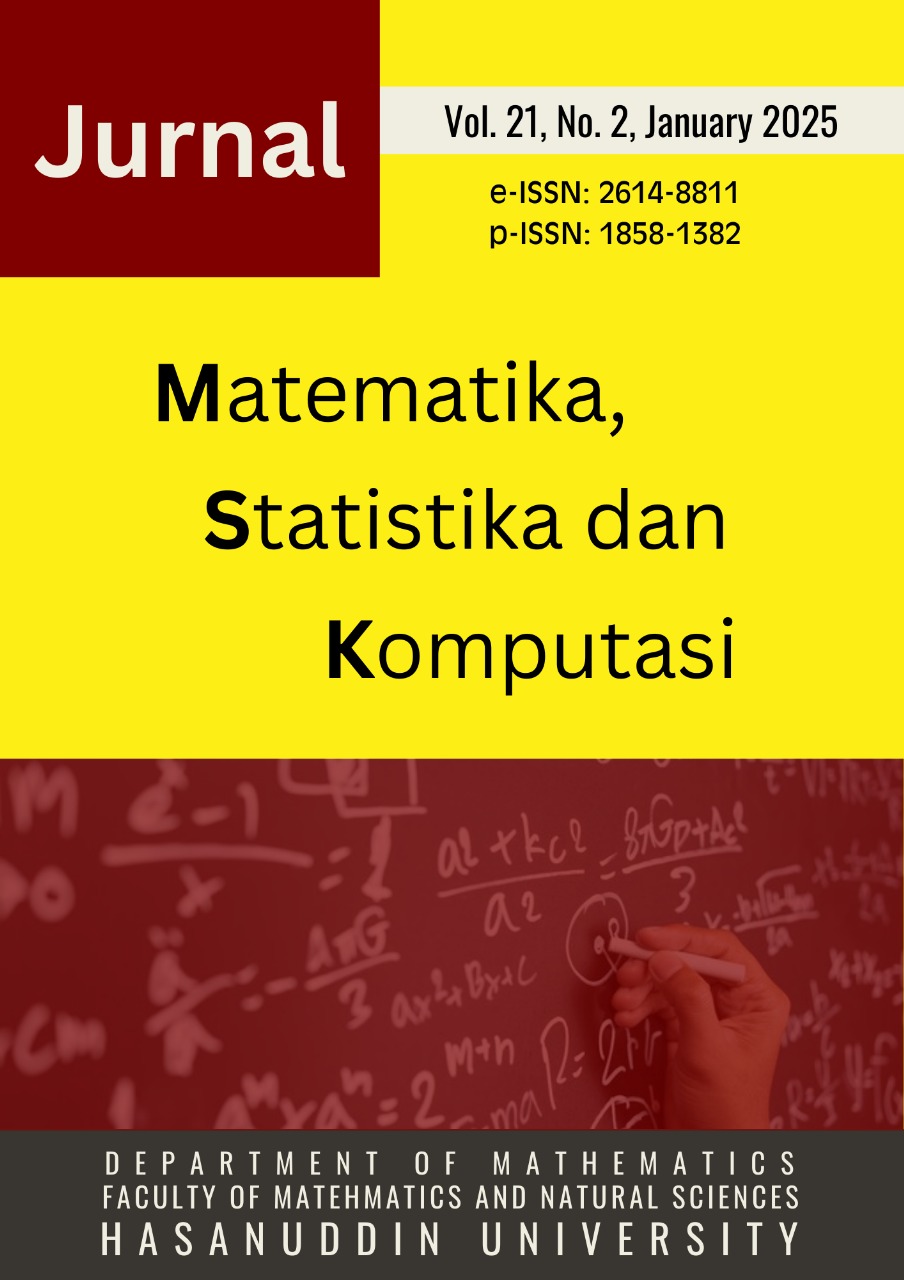Forecasting Dry Rubber Production in Indonesia for the Year 2022 Using Pegel's Exponential Smoothing Method with Modified Golden Section Optimization
DOI:
https://doi.org/10.20956/j.v21i2.37158Keywords:
Pegel’s Eksponential Smoothing, Modified Golden Section, Dry RubberAbstract
Pegel’s Exponential Smoothing is a forecasting method that considers separating trend and seasonal aspects, with additive and multiplicative models. Pegel’s Exponential Smoothing has three parameters, α, β, and γ. Many possible parameter combinations may yield an optimal solution, so a modified Golden Section method is used. The principle of this method is to iteratively reduce the boundary area of x that may produce an optimal objective function value, systematically decreasing the number of search steps to minimize the number of trials. Data obtained from the Central Bureau of Statistics regarding the amount of dry rubber production in Indonesian plantations from January 2017 to December 2022 is assumed to contain a multiplicative seasonal effect due to the relatively unstable seasonal pattern heights. This study compares three trend models: no trend, additive trend, and multiplicative trend in the multiplicative seasonal Pegel’s Exponential Smoothing method. This study aims to predict the amount of dry rubber production in Indonesian plantations from January 2022 to December 2022. Forecast validation results show that the multiplicative trend in the multiplicative seasonal Pegel’s Exponential Smoothing method, with a MAPE of 3.389001% and an RMSE of 8,839.965080, has the best forecasting accuracy for this data compared to the other three trend models.
References
[1] Al Ihsan, N. H., Dzakiyah, H., & Liantoni, F., 2020. Perbandingan Metode Single Exponential Smoothing dan Metode Holt untuk Prediksi Kasus COVID-19 di Indonesia. Ultimatics: Jurnal Teknik Informatika, Vol.12, No.2, 89–94. https://doi.org/10.31937/ti.v12i2.1689
[2] Al Qarani, M. A., Santoso, R., & Safitri, D., 2018. Pengembangan Estimasi Parameter Pada Metode Exponential Smoothing Holt-Winters Additive Menggunakan Metode Optimasi Golden Section (Studi Kasus: Wisatawan Mancanegara yang Menggunakan Jasa Akomodasi di DIY), Vol.7, No.4, 348–360. https://doi.org/10.14710/j.gauss.7.4.348-360
[3] Badan Pusat Statistik., 2023. Statistik Karet Indonesia. https://www.bps.go.id/subject/54/perkebunan.html#subjekViewTab4.
[4] Harahap, F. R., & Darnius, O., 2022. Optimization Of Holt-Winters Exponential Smoothing Parameters Using The Golden Section And Dichotomous Search Method. FARABI Jurnal Matematika dan Pendidikan Matematika, Vol.5, No.2, 104-115. https://doi.org/10.47662/farabi.v5i2.385
[5] Heizer, J., & Render, B., 2009. Manajemen Operasi. Jakarta: Selemba
[6] Mahkya, D. A., Yasin, H., & Mukid, M. A., 2014. Aplikasi Metode Golden Section Untuk Optimasi Parameter Pada Metode Exponential Smoothing. Jurnal Gaussian, Vol.3, No.4, 605-614. https://doi.org/10.14710/j.gauss.3.4.605-614
[7] Makridakis, S., Wheelwright, S. C., & McGee, V. E., 1999. Metode dan Aplikasi Peramalan, Jilid 1. Jakarta: Binarupa Aksara.
[8] Melyani, C. A., Nurtsabita, A., Shafa, G. Z., & Widodo, E., 2021. Peramalan Inflasi di Indonesia Menggunakan Metode Autoregressive Moving Average (ARMA). Journal of Mathematics Education and Science, Vol. 4, No.2, 67–74. https://doi.org/10.32665/james.v4i2.231
[9] Oral, Ö., 2019. Comparison of The Winters’ Seasonality Exponential Smoothing Method With The Pegels’ Classification: Forecasting of Turkey’s Economic Growth Rates. Anadolu University Journal of Social Sciences, Vol.19, No.3, 275-294. https://doi.org/10.18037/ausbd.632023
[10] Rahmawati, F.I., Eltivia, N., Kartika, E., Susilowati, K.D.S., 2020. Peramalan Kedatangan Wisatawan Mancanegara Indonesia: Metode Holt’s Winter Exponential Smoothing. Media Mahardika, Vol.18, No.2, 233-240. https://doi.org/10.29062/mahardika.v18i2.152
[11] Ruhiat, D., & Suwanda, C., 2019. Peramalan Data Deret Waktu Berpola Musiman Menggunakan Metode Regresi Spektral (Studi Kasus: Debit Sungai Citarum-Nanjung). Jurnal Teorema: Teori dan Riset Matematika, Vol.4, No.1, 1-14. http://dx.doi.org/10.25157/teorema.v4i1.1887
[12] Setiawan, D. A., Wahyuningsih, S., & Goejantoro, R., 2019. Peramalan Produksi Kelapa Sawit Menggunakan Winter’s dan Pegel’s Exponential Smoothing dengan Pemantauan Tracking Signal. Jambura Journal of Mathematics, Vol.2, No.1, 1–14. https://doi.org/10.34312/jjom.v2i1.2320
[13] Sinaga, Y., Wahyuningsih, S., & Siringoringo, D. M.. 2021. Peramalan Produksi Kelapa Sawit Menggunakan Metode Pegel’s Exponential Smoothing Prediction of Palm Oil Production Using Pegel’s Exponential Smoothing Method. Jurnal Eksponensial, Vol. 12, No.2, 165-174. https://doi.org/10.30872/eksponensial.v12i2.810
[14] Yuwida, N., Hanafi, L., & Wahyuningsih, N., 2012. Estimasi Parameter α dan β dalam Pemulusan Eksponensial Ganda Dua Parameter dengan Metode Modifikasi Golden Section. Jurnal Sains dan Seni ITS, Vol.1, No.1, A18-A22. https://dx.doi.org/10.12962/j23373520.v1i1.1003
Downloads
Published
How to Cite
Issue
Section
License
Copyright (c) 2025 Jurnal Matematika, Statistika dan Komputasi

This work is licensed under a Creative Commons Attribution 4.0 International License.

This work is licensed under a Creative Commons Attribution 4.0 International License.
Jurnal Matematika, Statistika dan Komputasi is an Open Access journal, all articles are distributed under the terms of the Creative Commons Attribution License, allowing third parties to copy and redistribute the material in any medium or format, transform, and build upon the material, provided the original work is properly cited and states its license. This license allows authors and readers to use all articles, data sets, graphics and appendices in data mining applications, search engines, web sites, blogs and other platforms by providing appropriate reference.







